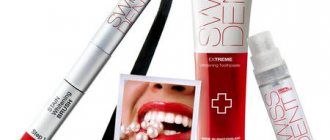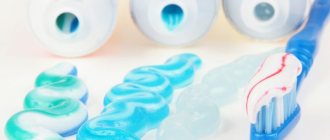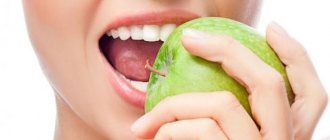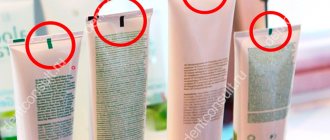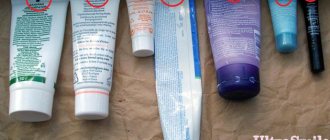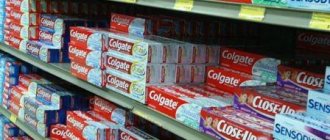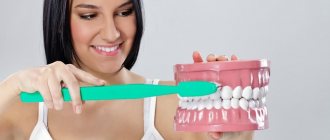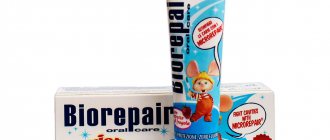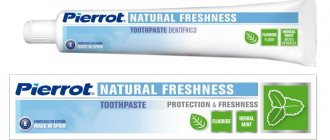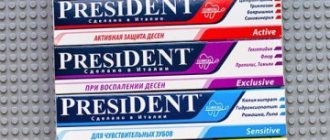An electric toothbrush is many times more effective than a manual one - it is easier to clean your teeth and it makes more movements per minute than we can imagine.
We constantly write about the fact that for safe use, you should not choose hard brushes and do not press the brush hard on your teeth. In this text we will tell you how to choose the right toothpaste that is suitable for use with an electric toothbrush.
Main components
Abrasives are responsible for removing plaque, otherwise known as cleaning or polishing agents. These include baking soda, silicon compounds, calcium carbonate or calcium phosphate. More expensive toothpastes contain a substance called hydrating silica, which is a better alternative to baking soda or calcium phosphate.
The abrasiveness of toothpastes is determined using the abrasiveness index. On the packaging it is marked with the abbreviation RDA (Relative Dentin Abrasivity). This indicator was invented by the American Dental Association. RDA determines the ability of a paste to disrupt the structure of tooth enamel and produce mechanical effects (enamel abrasion). It is believed that effective plaque removal is achieved with RDA values just above 100. Regular toothpaste consists of half abrasive components. If it contains more than 50% polishing agents, it can cause tooth sensitivity.
Almost any toothpaste contains foaming agents that save consumption and help fight plaque. However, large amounts of such substances cause irritation and redness in the mouth.
Flavorings and flavoring additives are added to the paste. Also, for normal consistency, toothpastes need binders (also called hydrocalloids) - components that help retain moisture so that bacteria do not grow in the paste, and preservatives.
Without all these components, toothpaste will not work. However, often instead of harmless natural flavors, abrasives and preservatives, chemists use harmful and life-threatening substances.
Complex
The main task of these pastes is the high-quality removal of bacterial plaque, creating freshness and purity of breath. These are preventive pastes for regular use for healthy teeth and gums. They do not contain active medicinal and biologically active substances, enamel whitening additives, or restorative complexes.
Pastes have low abrasiveness. They may contain natural ingredients that enhance consumer qualities and create an original taste and smell.
ROCS Maximum freshness. Classic paste with complex effects. Does not contain active chemical compounds. Suitable for both adults and children for regular use.
Marvis Classic Strong Mint, Classic Mint. An original paste, a tube made in retro style. The high quality of the paste is determined by the original composition, which gives it a unique taste and high hygienic qualities.
Dentaid Vitis with apple-menthol flavor. Paste for daily use. It has a healing effect due to the content of aloe vera extract.
What should not be in toothpastes
- Lauryl sulfate (Sodium Lauryl Sulfate) is a foaming agent that is part of cleaning products. Causes burning and itching in the mouth.
- Propylene glycol is a solvent used in industry. It is used as antifreeze or brake fluid. Particles that enter the body settle in the liver and kidneys and negatively affect their functioning.
- Triclosan (Triclosanum) is an extremely dangerous antibiotic that kills not only pathogenic microorganisms, but also has a detrimental effect on the kidneys and lungs. In medicine it is used only as prescribed by a doctor.
- Paraben is a preservative that increases the shelf life of products. It can be found not only in pastes, but also in shampoos, shower gels and bath foams. It is believed that this substance affects the development of malignant tumors. In 2004, experts studied the levels of parabens in breast cancer tumors. The presence of these substances in malignant tumors has indeed been proven, but the real reasons for their appearance have not been identified.
- Polyphosphates are a substance that softens water. Polyphosphates are included in almost all washing powders. There are suggestions that this particular component can cause an inflammatory process in the oral cavity.
- Chlorhexidine is a substance with an antimicrobial effect that can kill any microflora. With frequent use it causes dysbacteriosis in the oral cavity.
White Glo
The unique White Glo product provides maximum oral hygiene. Thanks to its special formula, the paste combats the yellowing of tooth enamel that occurs after consuming coloring foods and drinks.
Microwax particles protect tooth enamel from the formation of new stains. WhiteGlo contains vitamin-rich rosehip oil, which improves the protective qualities of the mucous membrane. The effect is noticeable after 3 days.
Composition of toothpaste depending on type
Pastes are divided into two main types: hygienic and medicinal. The former freshen breath and eliminate plaque, the latter fight a specific problem. Dentists, in turn, divide medicinal pastes into several more types. Only a dentist can help you choose the right remedy.
Sensitive paste
The doctor will recommend it if your gums and enamel are sensitive. This product contains potassium salts and strontium chloride. In this case, there should be extremely few abrasive substances in the paste. A substance called hydroxyapatite can also reduce gum sensitivity.
Examples of sensitive toothpastes:
- LACALUT Extra Sensitive.
- Sensodyne Gum health.
- PRESIDENT Sensitive.
#LIFEHACK
Doctors usually advise patients with hypersensitive teeth to use special gels, for example, the Russian drug RemarsGel, which cannot be found in pharmacies, but can be purchased to order in online stores. Sensitive gel is also available in the line of products under the brand name ROCS (Medical Sensitive Gel).
Whitening toothpaste
The main substances in this product are hydrogen peroxide and sodium bicarbonate. The composition may also contain an abrasive index (on the packaging it is designated as the RDA index) equal to 200, but in this case the paste cannot be used daily; it must be alternated with other brands every two to three days. However, your dentist should give more precise instructions for use. Regular toothpastes have RDA values slightly above 100.
Examples of whitening toothpastes:
- WhiteWash NANO.
- Lacalut White.
- Oral-B 3D White.
Anti-inflammatory paste
This remedy is prescribed by a doctor when periodontal disease or periodontitis is detected. In the composition of such pastes you can often find extracts of medicinal herbs.
Examples of anti-inflammatory toothpastes:
- Parodontax classic.
- DIAVIT Diadent Active.
- ASEPTA Active.
Strengthening toothpaste
Necessary for those who have enamel caries (light brown spots on the surface of the teeth). Such pastes must contain either fluoride or calcium. These two substances cannot be present together. It is also worth noting that fluoride in large quantities is harmful to teeth and can cause a disease called fluorosis (damage to tooth enamel). Fluoride paste should not be used for more than three weeks. A more effective and safer alternative to fluoride is glycerophosphate or calcium gluconate.
Examples of strengthening toothpastes:
- President Unique.
- Splat Biocalcium.
- ASEPTA Remineralization.
Carbamide peroxide for teeth whitening
Based on studies conducted by independent organizations, among whitening pastes, “ROCS PRO - Oxygen Whitening” demonstrates the greatest effectiveness. The composition contains carbamide peroxide - a substance that affects the deep layers of hard tooth tissue, discoloring pigments; The use of toothpaste allows you to achieve lightening by 2-3 shades in 30 days of regular use. The composition is safe: does not contain fluorides, parabens, artificial colors, sodium lauryl sulfate.
This is an active complex created on the basis of oxygen and urea. The last component is responsible for the permeability of the enamel and promotes deep penetration of oxygen into the hard tissue of the tooth. Radicals of oxygen compounds lighten the enamel during the cleaning process; Urea decomposes into components: carbon dioxide, urea (alkaline medium), ammonia. Carbamide peroxide, upon contact with water, enters into a chemical reaction, as a result of which oxygen is released and decomposition products are formed. A ten percent urea-based gel is converted into a 3.5 percent peroxide solution.
Cons: thinning of enamel, increased sensitivity of hard tissues.
What you should know about carbamide peroxide pastes
- It is recommended to use such pastes after professional teeth cleaning at the dentist. Not all dental plaque can be removed with a toothbrush. The remaining plaque and tartar will not allow the paste to evenly lighten the enamel, and there is a risk of stained teeth.
- It should be borne in mind that the active substance will not be able to whiten fillings, metal-ceramic and ceramic crowns. Only natural enamel is subjected to lightening. As a result, previously invisible fillings may appear, and beautiful crowns will appear dark against the background of lighter adjacent teeth.
- After completing a whitening course using products containing carbamide peroxide, it is recommended to switch to pastes containing calcium for a couple of months. And only after that use fluoride-containing pastes. This approach will strengthen weakened enamel.
Toothpaste and braces
When installing braces, you need to be more careful when choosing toothpaste. After all, the non-removable structure creates additional difficulties when brushing your teeth. In addition, while wearing braces, it is necessary to abandon whitening toothpastes so that after removing the corrective devices, the teeth are the same color. Dentists advise changing toothpastes at certain stages of teeth correction. For example, in the first months after installing braces, calcium is actively lost from the teeth, so pastes with a high content of this substance are needed. Then it is important to eliminate possible risks of caries, so strengthening toothpastes are suitable. At the final stages of wearing braces, doctors recommend switching to anti-inflammatory pastes to prepare the patient for painless removal of corrective systems. When choosing, you need to pay attention to the brands of those companies that specialize in producing toothpastes for braces, and consult with the treating orthodontist.
Examples of toothpastes for braces:
- ROCS PRO Brackets & Ortho.
- Gum Ortho.
- Dentaid Vitis Orthodontic.
Contraindications for teeth whitening
Lightening enamel with toothpaste or other means is not recommended for:
- Presence of caries;
- Enamel cracks;
- “Sensitive teeth” syndrome;
- Pregnancy, breastfeeding;
- Installed bridge structures, braces, bite alignment systems.
Whitening is carried out after eliminating the listed contraindications at home - with toothpaste or at the dentist. A doctor's consultation is required before the procedure.
Home enamel lightening is aimed at returning teeth to their natural color, removing tartar deposits and darkening.
Is it worth paying extra for luxury toothpaste?
Premium toothpastes add expensive and higher quality components, for example, hydroxyapatites, which are also called artificial tooth enamel. They help fight acids that are present in the mouth.
In addition, fluorine and fluorides are not found in luxury pastes; they are replaced with theobromine. This substance, which is obtained from cocoa beans, strengthens enamel and has an antibacterial effect.
Doctors also advise not to skimp on oral care products if you have recently installed an implant. Special toothpastes (Curasept ADS 712, Bluem, Implaclean) help the implant take root and have a good effect on the condition of the gums. When choosing between regular and premium toothpastes, you should understand that an expensive product will not help if you do not follow basic hygiene rules and do not visit the dentist every six months.
Splat
An effective Russian-made toothpaste contains an innovative formula for safe teeth whitening, suitable for very sensitive enamel.
- Polishing particles in combination with papain and polydon break down plaque in hard-to-reach areas, effectively lighten the enamel, making the surface of the teeth perfectly smooth.
- Potassium ions reduce the increased sensitivity of enamel. Natural antibacterial ingredients keep your breath fresh and prevent plaque buildup.
- Splat normalizes the pH balance of the oral cavity, preventing the development of caries, ensures the absorption of minerals and calcium, safely whitens and perfectly polishes enamel.
- Splat paste is ideal for lovers of strong tea, coffee and smokers. Within a month of use, the enamel is lightened by one and a half tones.
Harmless composition of children's toothpaste
When choosing toothpaste for a child, you need to look at the amount of fluoride. This substance is essential for children's teeth, but can be toxic in large quantities. Children from one to four years old need to select a toothpaste with a fluoride concentration of no more than 200 ppm (a unit of concentration that stands for parts per million). For children from 4 to 8 years old, products containing no more than 500 ppm of fluoride are suitable. From 8 to 14 you need to choose a paste with a fluoride content of about 1400 ppm.
You also need to look at the degree of abrasiveness. For children under four years of age, the RDA index should be no more than 20 USD, and for older children - no more than 50 USD. e.
Examples of children's toothpastes:
- Rocs Pro Kids.
- BioRepair.
- Splat baby.
Rembrandt
Rembrandt's action is based on the principle of low abrasiveness, the level of which corresponds to the standard of toothpastes for children.
Rembrandt lightens teeth by approximately 2 shades without damaging the enamel. This product contains citroxain, a mixture of the natural enzyme papain and a very mild polishing agent, which will return your teeth to their natural color.
Swiss Smile
Swiss Smile whitening product is the result of the latest research by scientists from Switzerland and is ideal for regular use. Its unique formula contains no chemically active substances, acids, abrasive components or other rough compounds.
A special combination of active ingredients perfectly whitens teeth, removes plaque and slows down its formation over a long period of time.
Colgate
High-quality Colgate toothpaste restores the natural whiteness of your smile by gently removing dark spots from the enamel surface.
Colgate is:
- regular use bleach;
- safe deep whitening;
- non-abrasive technology;
- protection against caries;
- fresh breath.

